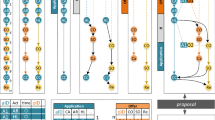Abstract
Representing and reasoning about time is fundamental in many applications of Artificial Intelligence as well as of other disciplines in computer science, such as scheduling, planning, computational linguistics, database design and molecular biology. The development of a domain-independent temporal reasoning system is then practically important. An important issue when designing such systems is the efficient handling of qualitative and metric time information. We have developed a temporal model, TemPro, based on the Allen interval algebra, to express and manage such information in terms of qualitative and quantitative temporal constraints. TemPro translates an application involving temporal information into a Constraint Satisfaction Problem (CSP). Constraint satisfaction techniques are then used to manage the different time information by solving the CSP. In order for the system to deal with real time applications or those applications where it is impossible or impractical to solve these problems completely, we have studied different methods capable of trading search time for solution quality when solving the temporal CSP. These methods are exact and approximation algorithms based respectively on constraint satisfaction techniques and local search. Experimental tests were performed on randomly generated temporal constraint problems as well as on scheduling problems in order to compare and evaluate the performance of the different methods we propose. The results demonstrate the efficiency of the MCRW approximation method to deal with under constrained and middle constrained problems while Tabu Search and SDRW are the methods of choice for over constrained problems.
Similar content being viewed by others
References
Allen, J. (1983). Maintaining Knowledge about Temporal Intervals. CACM 26(11): 832-843.
Baptiste, P. & Pape, C. L. (1995). Disjunctive Constraints for Manufacturing Scheduling: Principles and Extensions. In Third International Conference on Computer Integrated Manufacturing. Singapore.
Bessière, C., Isli, A. & Ligozat, G. (1996). Global Consistency in Interval Algebra Networks: Tractable Subclasses. ECAI'96. Budapest, Hongrie.
Bessière, C. & Régin, J. C. (2001). Refining the Basic Constraint Propagation Algorithm. In Seventeenth International Joint Conference on Artificial Intelligence (IJCAI'01), 309-315. Seattle, WA.
Chapman, D. (1987). Planning for Conjunctive Goals. Artificial Intelligence 32: 333-377.
de Kleer, J. (1986). An Assumption-based Truth Maintenance System. Artificial Intelligence 28: 127-162.
Dechter, R., Meiri, I. & Pearl, J. (1991). Temporal Constraint Networks. Artificial Intelligence 49: 61-95.
Dechter, R. & Pearl, J. (1988). Network-based Heuristics for Constraint Satisfaction Problems. Artificial Intelligence 34: 1-38.
Freuder, E. C. & Wallace, R. J. (1992). Partial Constraint Stisfaction. Artificial Intelligence 58: 21-70.
Golumbic, C. & Shamir, R. (1993). Complexity and Algorithms for Reasoning about Time: A Graphic-theoretic Approach. Journal of the Association for Computing Machinery 40(5): 1108-1133.
Haralick, R. & Elliott, G. (1980). Increasing Tree Search Efficiency for Constraint Satisfaction Problems. Artificial Intelligence 14: 263-313.
Hwang, C. & Shubert, L. (1994). Interpreting Tense, Aspect, and Time Adverbials: A Compositional, Unified Approach. In Proceedings of The First International Conference on Temporal Logic, LNAI, Vol 827, 237-264. Berlin.
Laborie, P. (1995). Une approche intégrée pour la gestion de ressources et la synthèse de plans. Ph.D. thesis, École Nationale Supérieure des Télécommunications.
Laborie, P. & Ghallab, M. (1995). Planning with Sharable Resource Constraints. IJCAI-95: 1643-1649.
Mackworth, A. K. (1977). Consistency in Networks of Relations. Artificial Intelligence 8: 99-118.
McAllester, D. & Rosenblitt, D. (1991). Systematic Nonlinear Planning. AAAI-91: 634-639.
Minton, S., Johnston, M. D., Philips, A. B. & Laird, P. (1992). Minimizing conflicts: A Heuristic Repair Method for Constraint Satisfaction and Scheduling Problems. Artificial Intelligence 58: 161-205.
Mouhoub, M., Charpillet, F. & Haton, J. (1998). Experimental Analysis of Numeric and Symbolic Constraint Satisfaction Techniques for Temporal Reasoning. Constraints: An International Journal 2: 151-164. Kluwer Academic Publishers.
Orgun, M. (1996). On Temporal Deductive Databases. Computational Intelligence 12(2): 235-259.
Pape, C. L. & Smith, S. (1987). Management of Temporal Constraints for Factory Scheduling. Temporal Aspects in Information Systems Conference, 165-176. Sophia Antipolis, France.
Sabin, D. & Freuder, E. C. (1994). Contradicting Conventional Wisdom in Constraint Satisfaction. In Proc. 11th ECAI, 125-129. Amsterdam, Holland.
Selman, B. & Kautz, H. A. (1993). An Empirical Study of Greedy Local Search for Satisfiability Testing. AAAI'93: 46-51.
Song, F. & Cohen, R. (1991). Tense Interpretation in the Context of Narrative. AAAI'91: 131-136.
van Beek, P. & Manchak, D. W. (1996). The Design and Experimental Analysis of Algorithms for Temporal Reasoning. Journal of Artifical Intelligence Research 4: 1-18.
Wallace, R. J. (1995). Partial Constraint Satisfaction. Lecture Notes in Computer Science 923: 121-138.
Zhang, Y. & Yap, R. H. C. (2001). Making AC-3 an Optimal Algorithm. In Seventeenth International Joint Conference on Artificial Intelligence (IJCAI'01), 316-321. Seattle, WA.
Author information
Authors and Affiliations
Rights and permissions
About this article
Cite this article
Mouhoub, M. Reasoning with Numeric and Symbolic Time Information. Artificial Intelligence Review 21, 25–56 (2004). https://doi.org/10.1023/B:AIRE.0000007179.60276.39
Issue Date:
DOI: https://doi.org/10.1023/B:AIRE.0000007179.60276.39




